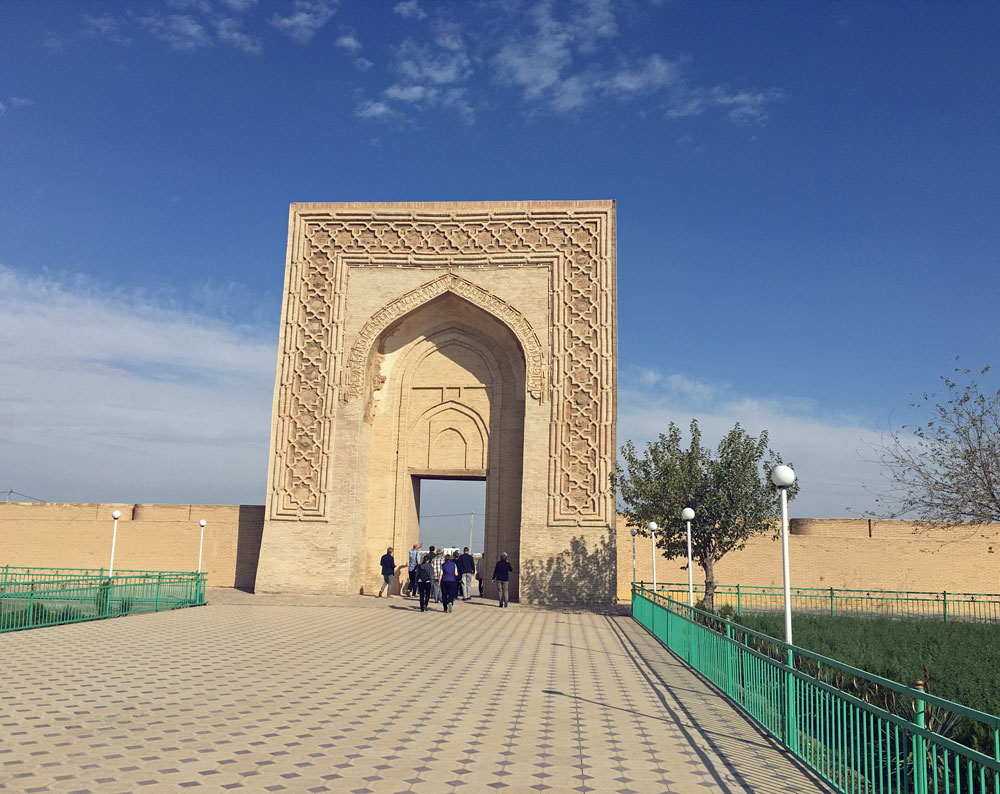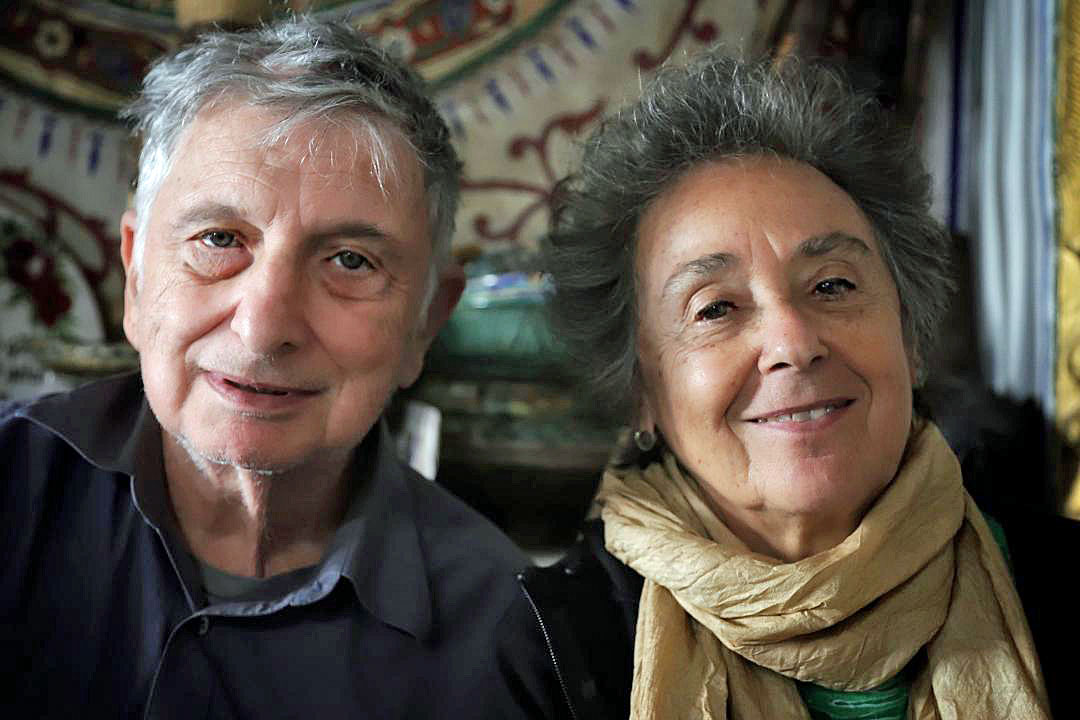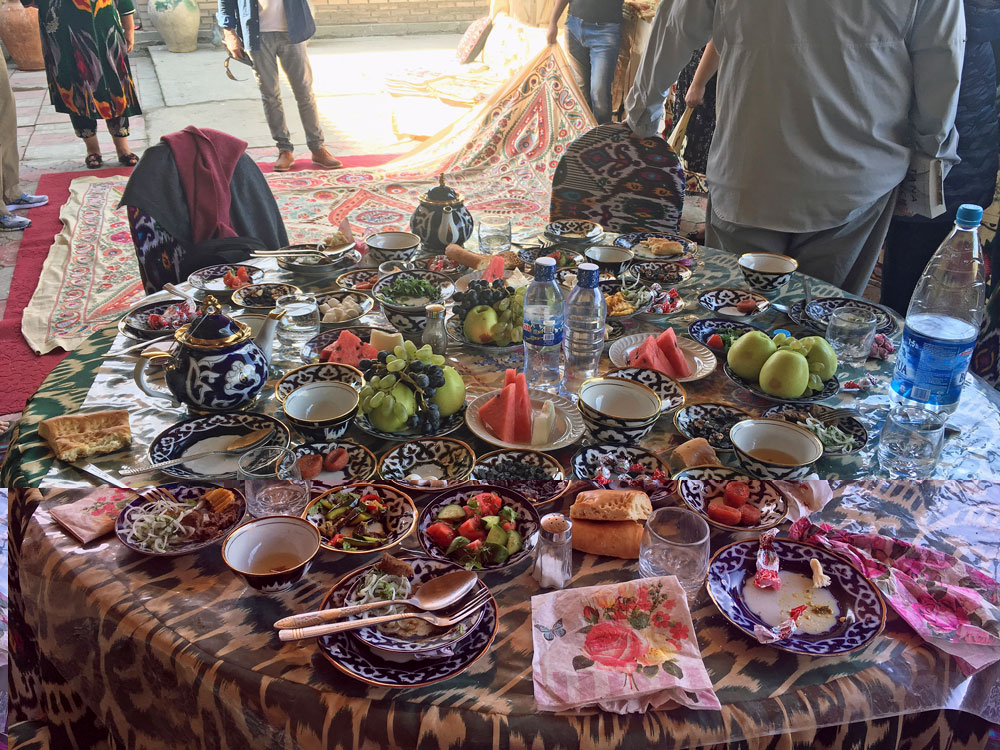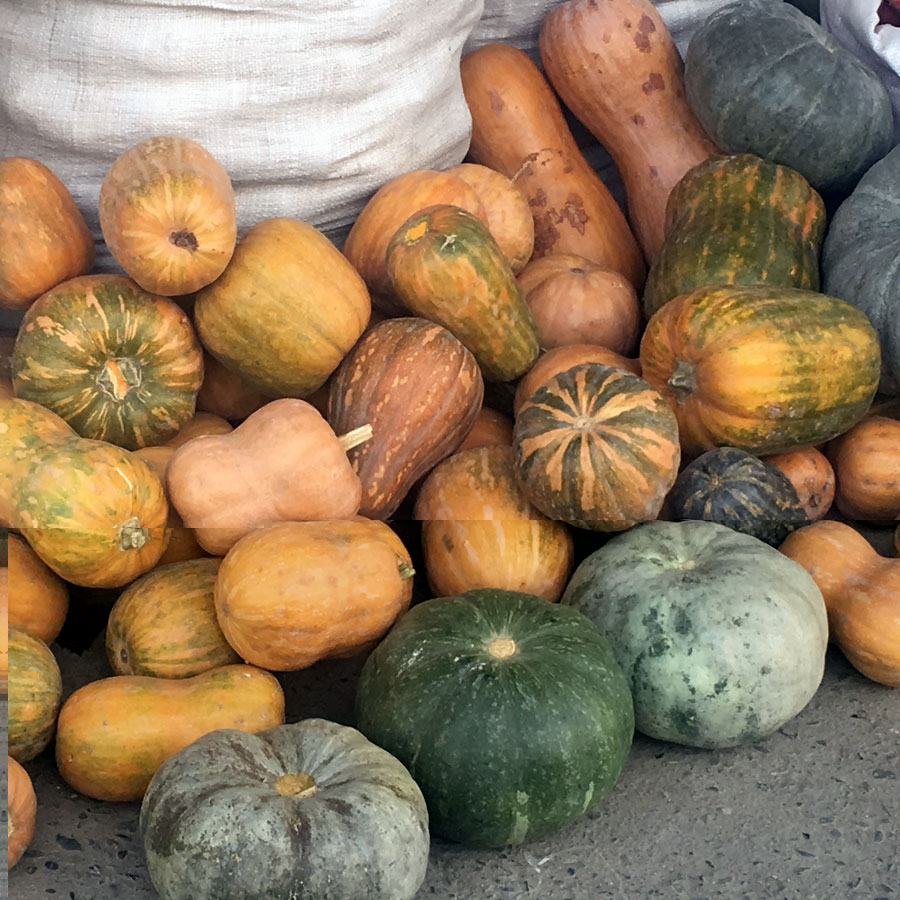



Uzbekistan is one of the world’s two doubly-landlocked counties: all the counties on which it borders are landlocked. (If you can’t guess the other country, go to the end of this account.)
Susan had always wished to visit Central Asia. I wanted to go there for the textiles. (Okay, just kidding.) We had signed up for a tour organized by Marilyn Romatka—from Seattle, a friend of Susan’s from Weave a Real Peace—and run locally by Salom Travel.
There are several ways to travel from New York to Uzbekistan. All take a long time. We flew Turkish Airlines, with a layover in Istanbul. The airport there opened only this year. It is a massive structure with shining floors and cathedral-high ceilings. It is very spread out, which means you may have to walk more than 20 minutes to your destination. We had a lengthy layover, so we booked a room at the airport yotel for three welcome hours. You get a small white room with bed, bath and shower. Worth it.
After a full day’s travel, we arrived in Tashkent in the morning. We were nine hours ahead of New York time, so our minds and bodies had to make adjustments. We were picked up by Azat, a Tatar whose family had come from the Russia in the 1930’s. He would be our guide for two and a half weeks, starting the next day. He told us that his first identity was as a Tatar and Muslim, not as Uzbek.
We were a group of 12: eight Americans and four Australians, some of them transplants. It was a congenial bunch, with no complainers or chronic late-comers. (In contrast, we later encountered a group of 19 Americans. They had booked 17 rooms for the 19 of them. They were spending only about five days in the country. They demanded that waiters don white gloves when serving them.) We were more women than men and more older people than young ones (there were no young ones). Our Hotel Uzbekistan (its name) was 16 stories high, with a front exterior devoted to huge flashing advertisements. The hotel was clearly designed for groups: the dining room had only round tables, each seating 12.
Susan somehow made it to the market that first morning. I waited until afternoon to have a look at the city. It is the capital and by far the largest in the country, some 2.6 million. I swiftly summed up the local population: olive skin, black hair, slender when young. Not much English spoken—try Uzbek or, even better, Russian.
The tour proper began Friday, Sept. 20. Before continuing, I should say that its two main attractions—apart from just being in Central Asia—were the monumental religious buildings, and the textiles and ceramics. Because the latter are Susan’s specialties, I am asking her to write about them (appendix A).
HISTORY
The country became part of the Soviet Union in 1924; it declared independence in 1991. From then until his death in 2016 it was ruled by Islam Karimov. Despite his name, he was not a supporter of religion. His was a ruthless regime, with many victims of repression. Under his successor the country has relaxed but is still described as “an authoritarian state with limited civil rights.”
When the USSR took over, it turned enormous areas from pastoralism to production of cotton. Many people were displaced. Rivers were diverted to feed the water-hungry cotton plants. The inland Aral Sea, once the 4th-largest in the world, has almost entirely dried up.
SILK ROAD
Actually a number of trade routes central to east-west commerce for two millenia.
Bukhara and Samarkand were especially important locations. Read about the Silk Road.
UZBEKISTAN 2 (by Susan)
Uzbekistan, we found, is truly a melting pot through, over the centuries, forced and voluntary migration. We had been told to expect to see Korean-Uzbeks (and there is a Korean Uzbek restaurant nearby in Brooklyn). We also know that Jews fled the USSR early in WW II to Uzbekistan, which was a place of safety for them; no fighting took place there and they were safe both from the war and the Germans. A friend has told us that her parents and family picked cotton and were relieved to be safe from the depredations of war. As soon as the war ended, they went to a DP Camp and then the USA. We also learned that Anna Akhmatova and other intellectuals were relocated from Leningrad early in the war.
There were forced “evacuations” by Stalin of communities he did not trust or found inconvenient. This includes the Tatars and Koreans. Koreans first arrived in Uzbekistan in large numbers in 1937; they were the first nationality to get sent to remote Uzbekistan as “unwanted ethnic minorities” in the Soviet Union. Over previous centuries Koreans had emigrated due to economic pressure. The Koreans who were deported were from the Soviet Far East, between NE China and present-day N Korea. Thousands of people died in these forced moves. We saw an amazing variety of faces on our tour. Women wore head scarves, or not (about half.). We never saw a woman wearing a veil or anything other than colorful dresses —except in Nukus where the women were dressed in very contemporary attire.
What we did not see is the Jewish community which had been a sizable population in Uzbekistan. Over the centuries the Jewish and Muslim communities were integrated in many ways; there was some discrimination—of course. Jews at certain times were not allowed to ride horses, only donkeys, and were not permitted to wear leather belts, only cloth ones. This community took advantage of the USSR allowing Jews to migrate in 1972. And we can now find Uzbek Jews living in Israel, Queens and Brooklyn (need a haircut?).
JEWISH PRESENCE
By Susan:
There were several distinct Jewish communities in Uzbekistan, most prominent are the Bukharan Jews and it was in Bukhara that we visited a synagogue (conveniently across from our hotel) and the Jewish cemetery which was fairly well maintained, presumably by immigrants who have elderly parents still living in Bukhara. It has about 10,000 graves. There was an Ashkenazic community in Tashkent which was very distinct from the Bukharan Jews. The first synagogue was built in Bukhara in 1620. The Bukharan Jews are Sephardic and spoke neither Ladino, Yiddish nor Hebrew but rather a Persian dialect. (Newly learned fact - Yosef Maimonj, a Jew from Morocco, found his way to Bukhara in 1793. His descendants include the author Jeffrey Masson and Dorrit Moussaieff, the former First Lady of Iceland! Who knew?) A long Wikipedia account.
OUR GUIDE
Azat was excellent. He spoke fluent if accented English and seemed to know everything. He told many funny stories on long bus rides. He had served in the Soviet army and was amazed that we had been fearful of its troops. They barely had enough to eat, he said, and were given only one new uniform every three years.
CURRENCY and EXPENSES
The favorable exchange rate made the trip relatively inexpensive. When the country left the ruble, it created a new currency, the soum. Inflation soon diminished its value, but for a time 5000 soum notes were the largest. You needed a backpack to carry large sums. When we arrived, a dollar equalled about 9500 soum. There are now larger denominations, but they were not always available. So when I changed two hundred-dollar bills at the hotel, I received more than 400 5000-soum notes. NOTE: your dollars must be relatively new issues, and good and clean; they won’t be accepted otherwise. There are few ATMs, and fewer that work. Credit cards (Visa) are rarely used.
On the tour, all meals and accommodations had been pre-paid. We pooled our tips at the beginning, so we wouldn’t have to worry about them.The main need for soum was for beer and wine (minor—and surprisingly available in an Islamic state) and ceramics and textiles (major).
FOOD
Hotel breakfasts were standard. Fried eggs and omelets usually included. Skip the pastries. Lunch and dinner both tended to start with very fresh salad, followed by soup and a main course with lots of meat. Bottled water always. Could sometimes order off the menu Have to admit that the meals I liked most were big, cheesy pizzas. Taking orders for 13 (including Azat) in a foreign language could be confusing. One very young waitress insisted that our table had asked for three soups, rather than two. She kept foisting one on me. I finally exclaimed “Nyet,” which upset her. She said plaintively, “Are you sad for me?” Or maybe it was “Are you mad to me?” Whatever. I told her I was not. Then we posed for a photograph together.

ACCOMMODATION
We stayed at five hotels. All had twin beds, private bathrooms and televisions, which we never turned on. In most cases, used toilet paper went into the trash rather than the bowl. Anyone who has traveled in South or Central America will be familiar with this practice. Outside Tashkent, the hotels were small and congenial, especially the Ikat Hotel in the Margilan valley.
FORMALITIES
U.S. citizens need a visa. You can get one for less, but Susan and I paid $75 each for a printed version. Be sure to retain this throughout your visit. Most hotels will want to register it, along with your passport. You should also keep hotel registration receipts, in case you are asked for them on departure (we were not). We had also been warned about prescription medications—they might be checked on arrival and a stiff fine issued if you were suspected of smuggling drugs. So don’t have an 9mplausible surface. (We walked out of the Istanbul airport without anyone looking at anything.)
GETTING AROUND
Tashkent has a subway system. It’s efficient though somewhat limited; the stations are beautiful, but far apart. For some reason, the day we used it, it was also free. Main city arteries, especially in Tashkent, are astonishingly wide—up to five lanes each way. They have a central barrier, with few breaks. This means that you must drive some distance and make a u-turn into traffic to reach the other side of the road. This is especially difficult for buses, but the drivers are very skillful. This arrangement will turn problematic as traffic grows. There are already many cars. Most of them are colored white, reportedly to conceal all the dust that flies around. Still a few ancients Ladas around. Taxis are usually yellow.
Roads between main cities are quite good, or becoming so. We had three train trips. Reserved seats, pretty comfortable, especially the non-stop “bullet train” from Samarkand to Tashkent.
We had one internal flight—slightly over an hour from Tashkent west to Nukus. Thence it was back east—by bus until the final train trip from Samarkand to Tashkent.
BUILDINGS AND MONUMENTS
I hope that the photographs will convey some of the scale. The profusion of monuments that we saw in Khiva. Bukhara, and Samarkand was astonishing. In Khiva especially the buildings have their own area, distinct from the modern cities that surround them. Ancient Khiva remains a walled city in which we stayed. As there have been no large armed conflict in Uzbekistan (no bombs fell during WW II) the ancient mosques and madrassas have been left standing throughout the centuries. And although the Soviet Union (tried to) forbid the practice of religion, mosques were other ignored or used for other purposes. The buildings that were in poor shape have mostly been restored.
GLASSES
One of our group brought a great many reading glasses, which we distributed among artists who were doing close work, like embroidering. The women (who do the close work of weaving and embroidering) were thrilled to receive this gift.
THE WEDDING

We were invited to a local wedding, we don’t know why. By the time we arrived, the festivities were well under way: About250 guests, very loud music, lots of dancing. The happy couple spent the whole wedding on a dias, looking down at their guests, the woman bowing, not mixing with their guests. The tables were crowded with the usual Uzbek food, plus a great deal of vodka. We took a few sips, but could eat nothing as we had just had our Uzbek dinner. We were quickly pulled into the dancing, and were considered minor stars.
VISITS TO LOCAL HOMES
We spent one —somewhat unfortunate—night at a “home stay.” We and two friends were given rooms —that the family vacated for the night—sleeping comfortably on the floor, using the rather distant outdoor toilet, and smiling a lot at our hosts who knew no English. We had a few more successful visits with families including a great evening of singing and dancing (and of course shopping) in Margilan.
Appendix A (by Susan)
For some of us Uzbekistan was largely of interest because of the textiles - seeing the textiles and the weaving that we’ve admired from afar. The trip certainly met my expectations! Almost every day (okay, we did have to travel on some days, and the mosques and monuments were magnificent) we were seeing textiles, buying textiles, interacting with their makers, seeing the artisans at work. This began the day after we arrived in Tashkent when we visited the Museum of Applied Arts and the oldest part of town to meet a block printer who works out of his home with his family (as did most of the artisans we met). He described his technique (which is a dying art); while the blocks have traditionally been carved by hand recently some are 3-D printed! This visit was where the shopping began!
We then visited a Suzani workshop, also in a private home where local women (often family members) embroider extraordinary decorative textiles. In every community we visited on the trip we saw Suzani embroiderers; it is impossible to pick out a favorite as all the work was so beautiful! Before experiencing total exhaustion we stopped at the first of the three ceramicists we visited during our trip, (Akbar Rakhimov) ; each had very different techniques and styles to show us (and, of course, we had to buy something at each of their studios. Come visit Brooklyn and get a tour of our purchases). Later in the trip we also visited the workshop of Rustan Usmanov in Ristan (he is a frequent seller at the Santa Fe Folk Market) and Akbar and one other potter, name forgotten.
The next day we took the train to Margilan, where we spent four nights at our favorite , Ikat House, built in traditional style (the home built around a garden courtyard); this hotel is owned by Rasuljon Mirzaakhmedov, a famous Ikat weaver with whom we spent who accompanied us on some of our visits in Margilan. Ikat - for those of you who don’t know—is a technique used to make pattern on textiles that employs tying the threads (known as a resist) prior to dyeing and weaving the threads. Some of us in the group had some experience with Ikat weaving; I can say that I found my one attempt difficult and frustrating—and not worth the effort. Luckily, I’m not doing this for a living, unlike those we saw in Margilan. They are working on a massive scale, producing yardage for export and local use.
It was fascinating—to some of us—to see the production, the slow but efficient tying of bundles and preparation for dyeing. Ikat production has about 37 separate steps, all made by a different artisan. In the next four days, spent in Margilan, we visited many (Steve would say many, many) workshops to see the silk production, dyeing of Ikat and weaving, mainly in small workshops but also in a (very noisy) factory. (We were told that the owners would make no effort to reduce noise or pollution in the factory as that would decrease profits.)
The silk production, which we saw in workshops throughout our visit, is very interesting. The cocoons are fed mulberry leaves and silk production is State run to the extent that people must sell their cocoons to the State which then sells them to individual workshops. Uzbekistan is the third-biggest silk producer in the world. From the end of April to late May farmers tend the silkworms, in their own homes. (Very smelly and labor-intensive, we’re told). Farmers receive tiny silkworms in a box; the 40 grams contain thousands of larvae whose job it is to eat and grow. The newly hatched silkworms are tiny and eventually expand enormously. They eat an exclusive diet of mulberry leaves: about 2 Kilograms a day are needed at the beginning. At their peak, larvae can eat up to 270 K of fresh leaves daily. At the end of the season, a family might harvest up to 120 K of raw cocoons; they get paid $2 per kilogram by the authorities. There’s a great deal of pressure on farmers to participate in this industry! The silkworms are then sold to the weaving workshops where they are boiled (yes, sorry) and the silk extracted in a slow and laborious process (which we observed). A worker will take about 100 threads (from 100 cocoons) in her hand and process them into one hand...
Oh, can’t forget that we also saw some velvet weaving; that is an amazing process and Uzbekistan is one of the few places (some in Italy) where velvet is still woven on handlooms. And amazingly beautiful carpet weaving. (We saw no children working on our visit. They were in school, or playing nearby.) The carpets are often sold in Turkey and, we were told, are described as Turkish, rather than Uzbek, carpets as this will get higher payment. Interspersed with these visits to homes and workshops we went to several wonderful markets. Every town has its own market with everything under the sun you may need—brooms, chickens, rabbits, underwear, cloth, Ikats, shoes, show repair (which I needed one day), salads (fabulous) apricots (why did I think I needed to bring dried apricots to Uzbekistan?), old Ikats, old Suzanis. The merchants were very happy to see our little group! But in general it was not at all the hard sell we’ve experienced in other countries, until we got to the last market, in Urgut, about 50 K from Samarkand. There was a selling (and purchasing) frenzy going on as we knew this was the last opportunity of the trip to get that one last Suzani, or Ikat jacket, or whatever we suddenly realized we couldn’t live without. My favorite purchase of the trip, a long silk robe, turns out to look rather like a bathrobe on the NY subway, not as stately as it seemed in Uzbekistan.
We visited six different cities/towns; the shortest stay was two nights in Nukus, which is not on the usual tourist trail. This required a short but very early plane ride to the Karkalpakstan region (try saying that). The Nukus Museum of Art was our destination; the Savitsky Museum has 82,000 items and especially known for its large collection of Russian avant-garde art. I will leave remarks about the quality of much of the art to others. Savitsky is largely known for having rescued works of art that had been banned by Stalin who apparently didn’t really care what was going on in Nukus. We especially enjoyed the large collection of textiles. We most enjoyed our stays in Bukhara and Samarkand because there we could walk around a real city and get a feel for the non-touristic life. (In Margilan we were so busy that we really didn’t have the time to do much wandering on our own; our only stop “in town” was to buy beer). In Bukhara we took a long walk (made much longer by getting lost) to the Jewish Cemetery. We were reminded how little English is spoken as we tried to explain “Jewish” and “cemetery” as we were asking for directions. People were very friendly and not at all helpful as they had no idea what we were talking about—except for one moment when, as we were turning onto a path, a fellow said emphatically “Nyet.” So we took the path to the right. But this did get us out into real neighborhoods and away from the touristic area.
I did my own wandering to the bathhouse in Bukhara, 500 years old; I would never have found it without a guide from our hotel. (Of course, I ran into someone I knew from NY in Bukhara ; not a big surprise as Christine Martens is a scholar who leads trips to Uzbekistan regularly.). There didn’t seem to be much effort to modernize in the last 500 years, except for the lockers for clothing. Cost was $20.00, 10,000 soum. When the guide was asked if she, living in Bukhara, ever goes there she said, why would she as she can go to the new modern one in a local hotel. This was an experience where you just have to go with the flow! Take off your clothes, follow the scantily clad large woman, do whatever she says. Which is sit, have water poured on you, lie on the flagstone floor (interesting conversation with equally nude women from Hong Kong), get up when told, get scrubbed vigorously, get lightly massaged, then get told “finish.” Worth every soum. In Samarkand we also did some wandering, to the local market, with Bettes and Larry to the synagogue (closed when we were there); this was a large Jewish community that has almost entirely moved since Jews were allowed to leave the USSR. There was no sign of this community other than the synagogue and a Jewish cemetery that we didn’t visit. Interesting to us—the chief occupation of the Jews of Central Asia in the past was dyeing yarn and cloth, particularly with indigo!
Appendix B
The other doubly-landlocked country is Liechtenstein.
Return to travel page.
Return to home page.